21世纪大学实用英语(全新版)U5-B2教学方案
- 格式:doc
- 大小:101.00 KB
- 文档页数:13
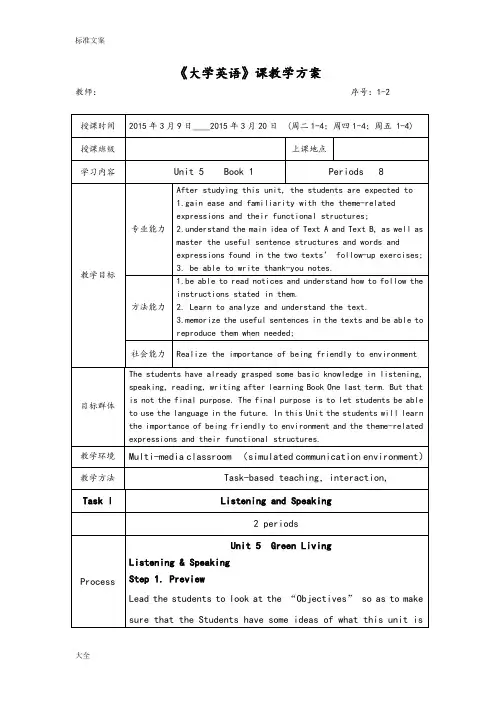
《大学英语》课教学方案教师:序号:1-2授课时间2015年3月9日____2015年3月20日 (周二1-4;周四1-4;周五 1-4) 授课班级上课地点学习内容 Unit 5 Book 1 Periods 8教学目标专业能力After studying this unit, the students are expected to1.gain ease and familiarity with the theme-relatedexpressions and their functional structures;2.understand the main idea of Text A and Text B, as well asmaster the useful sentence structures and words andexpressions found in the two texts’ follow-up exercises;3. be able to write thank-you notes.方法能力1.be able to read notices and understand how to follow theinstructions stated in them.2. Learn to analyze and understand the text.3.memorize the useful sentences in the texts and be able toreproduce them when needed;社会能力Realize the importance of being friendly to environment目标群体The students have already grasped some basic knowledge in listening, speaking, reading, writing after learning Book One last term. But that is not the final purpose. The final purpose is to let students be able to use the language in the future. In this Unit the students will learn the importance of being friendly to environment and the theme-related expressions and their functional structures.教学环境Multi-media classroom (simulated communication environment)教学方法Task-based teaching,interaction,Task I Listening and Speaking2 periodsProcessUnit 5 Green LivingListening & SpeakingStep 1. PreviewLead the students to look at the “Objectives” so as to make sure that the Students have some ideas of what this unit isall about.Step 2. Part I Listening1.Listen to the upcoming short talk and then fill in the blanks in the sentences that follow with two or three words. First getting to know the useful language below might be helpful.Useful Languageextreme weather 极端天气activity n. 活动planet n. 星球up to 在于…, 取决于…go green 要有环保意识,保护环境for the sake of 为了breathe vt. 呼吸provide for 为…提供call for 要求carbon footprint 碳足迹(二氧化碳排放量)reduce vt. 减少urbanization n. 城市化turn a blind eye to 对…熟视无睹Script:Hi, everybody,Both the Beijing Olympics and the Shanghai Expo called for “green life.” How about your carbon footprint today? What have you done to reduce it?China is a big country with a large population. As in many other countries, urbanization is growing rapidly in China, which means more and more people are moving to the cities. As a result, the cities are getting bigger, and thus warmer. Today, nobody can turn a blind eye to such things as weather change, global warming, sea level rise, and extreme weathers. As you know, such things have much to do with our human activities. So we can’t go on like this. Nothing can be more important than to save our planet. This is the only planet onwhich we live.What should we do then? This is a question to all of us. It is up to each and every one of us to “go green.” Let’s live a low-carbon life, and reduce our carbon footprint —for the sake of our planet and for ourselves.Nobody can give up breathing, drinking and eating. But we’ll have nothing if our planet cannot provide for us.2. In the upcoming conversation, Christine and Charles are talking about a new light source. Listen to them and then decide whether the conversation-based statements below are true or false. First getting to know the following useful language might be helpful.Useful LanguageLED 发光二极管Emit vt. 散发diode n. 二极管semiconductor n. 半导体increasingly ad. 光源light source 越来越多的remind vt. 使想起Unforgettable a. 难忘的electricity n. 电switch n. 转变I can’t imagine. 很难想象environment-friendly a. 环保的defnitely ad. 一定Script:Christine: Did you say LED? What do you mean by that? Charles: It’s the short form for light-emitting diode. Christine: I don’t get it. What’s that?Charles:Well, a LED is a semiconductor light source. Everywhere, LEDs are increasingly used for lighting. Expo 2010 Shanghai China is a good example.Christine: Oh, I see. You just reminded me of my trip to theExpo site. The lights were beautiful that evening. They were colorful and intensely bright. It was a really unforgettable trip.Charles:I bet it was. By the way, do you know how much electricity LEDs can save?Christine: I can’t imagine. But from what you said, I can tell the future of lights relies on LEDs.Charles:Yeah, the switch is already happening. In time, I’m sure their use will be even wider.Christine:You’ve got to be right. They are really environment-friendly. That’s so important!Charles:Yes, they are. We can definitely live a more low-carbon life with them.Christine: It sure is a good step in the right direction. Step 3. In the upcoming conversation, Charles and Christine are talking about the London Case Pavilion. Listen to them, and then answer the questions by choosing the best answer. Script:Charles:Speaking of energy efficiency, what was your favorite Shanghai Expo pavilion?Christine:I would say the London Case Pavilion. It’s a zero-carbon pavilion.Charles:I totally agree! When I visited it, I had lunch in the zero-carbon restaurant.Christine:Did you?Charles:Yes, I did. You know, even the chopsticks and dishes could be eaten right along with the food, because they were made of chocolate and pastry.Christine:You’re telling me! No wonder it’s really zero-carbon!Charles:Just about every square inch at the Expo site sent the same message: live a low-carbon life in every possible way. Christine:That’s so true. To have a better city is to have a better life.Charles:You took the words right out of my mouth. We cannottalk about a city without talking about its way of life.Christine:I know what you mean. And leading a low-carbon lifeis key to bettering our city.Charles:Hey, look! So many lights are on, right over our headsin this classroom!Christine:Let’s kill them. The light from all these windowsis plenty.Charles:You kill these. I’ll take care of the rest.Christine:Ok.Homework Preview Text ATask II Text A How Green Is My City2 periodsProcess StepI Starter of the TextStepII Explanation of Text APara. 1 of Text A1. Questions about This Paragraph1) What is the main idea of the first part of the text?New ideas have enabled people to live clean and green in the city.2. Language Points1) think about: remember or consider想到;考虑e.g. I thought of you when they wanted someone who could speak English.当他们需要一个会讲英语的人时,我想到了你。
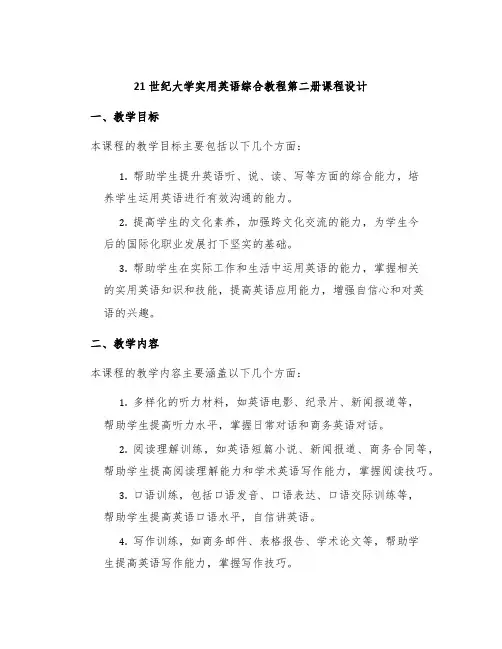
21世纪大学实用英语综合教程第二册课程设计一、教学目标本课程的教学目标主要包括以下几个方面:1.帮助学生提升英语听、说、读、写等方面的综合能力,培养学生运用英语进行有效沟通的能力。
2.提高学生的文化素养,加强跨文化交流的能力,为学生今后的国际化职业发展打下坚实的基础。
3.帮助学生在实际工作和生活中运用英语的能力,掌握相关的实用英语知识和技能,提高英语应用能力,增强自信心和对英语的兴趣。
二、教学内容本课程的教学内容主要涵盖以下几个方面:1.多样化的听力材料,如英语电影、纪录片、新闻报道等,帮助学生提高听力水平,掌握日常对话和商务英语对话。
2.阅读理解训练,如英语短篇小说、新闻报道、商务合同等,帮助学生提高阅读理解能力和学术英语写作能力,掌握阅读技巧。
3.口语训练,包括口语发音、口语表达、口语交际训练等,帮助学生提高英语口语水平,自信讲英语。
4.写作训练,如商务邮件、表格报告、学术论文等,帮助学生提高英语写作能力,掌握写作技巧。
5.翻译训练,如英汉互译、商务口译等,帮助学生掌握翻译技巧和方法,提高翻译能力。
三、教学方法针对本课程的教学目标和教学内容,我们将采用多种教学方法来帮助学生提高英语综合能力,包括:1.互动式教学法,通过提问、互动、讨论等形式,引导学生主动参与课堂,培养学生思考和创新能力。
2.探究式教学法,通过实践性任务、小组合作、角色扮演等方式,激发学生学习兴趣和学习动力,培养解决问题的能力。
3.语境式教学法,通过将课堂教学和现实情境相结合,促进学生在实际环境中学习和练习英语,培养学生的实际应用能力。
4.多媒体教学法,通过电子板书、多媒体配图和音频视频等方式,为学生打造更为生动、直观的学习环境,促进学生的学习效果。
四、教学评估本课程的教学评估主要包括两个方面:1.学生成绩评定,根据学生的听、说、读、写等能力测试成绩,对学生的英语综合能力进行评估。
2.学生反馈评价,通过教学问卷、德育评价、班会纪要等方式,收集学生对课程和教学的反馈,了解教学的效果和存在的问题。
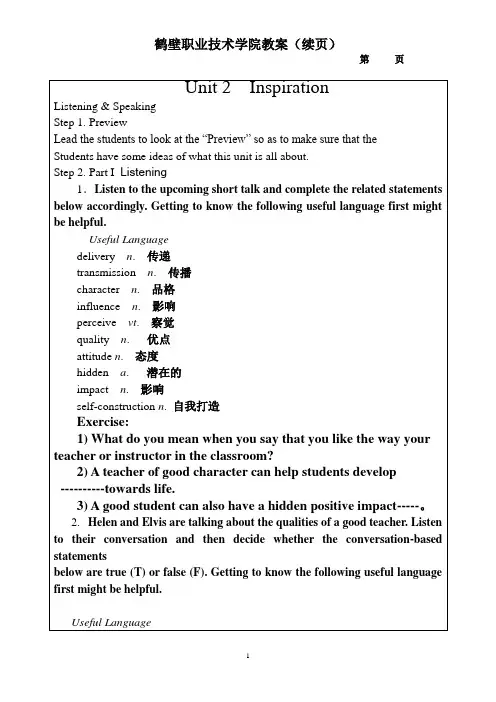
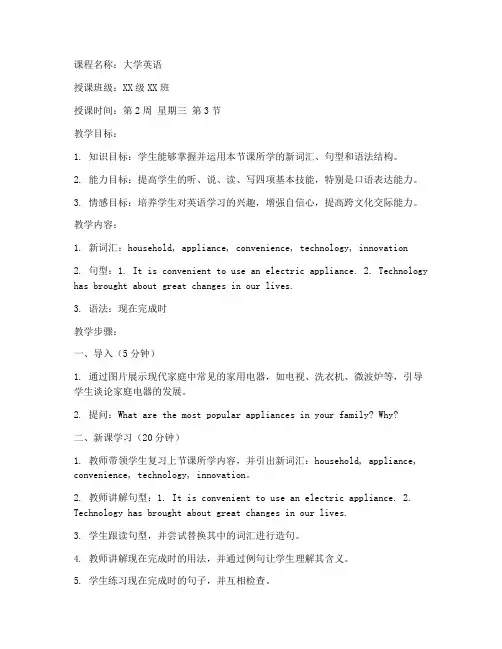
课程名称:大学英语授课班级:XX级XX班授课时间:第2周星期三第3节教学目标:1. 知识目标:学生能够掌握并运用本节课所学的新词汇、句型和语法结构。
2. 能力目标:提高学生的听、说、读、写四项基本技能,特别是口语表达能力。
3. 情感目标:培养学生对英语学习的兴趣,增强自信心,提高跨文化交际能力。
教学内容:1. 新词汇:household, appliance, convenience, technology, innovation2. 句型:1. It is convenient to use an electric appliance. 2. Technology has brought about great changes in our lives.3. 语法:现在完成时教学步骤:一、导入(5分钟)1. 通过图片展示现代家庭中常见的家用电器,如电视、洗衣机、微波炉等,引导学生谈论家庭电器的发展。
2. 提问:What are the most popular appliances in your family? Why?二、新课学习(20分钟)1. 教师带领学生复习上节课所学内容,并引出新词汇:household, appliance, convenience, technology, innovation。
2. 教师讲解句型:1. It is convenient to use an electric appliance. 2. Technology has brought about great changes in our lives.3. 学生跟读句型,并尝试替换其中的词汇进行造句。
4. 教师讲解现在完成时的用法,并通过例句让学生理解其含义。
5. 学生练习现在完成时的句子,并互相检查。
三、口语练习(15分钟)1. 学生分组,每组选择一个话题,如:The impact of technology on our lives, The convenience of household appliances等。
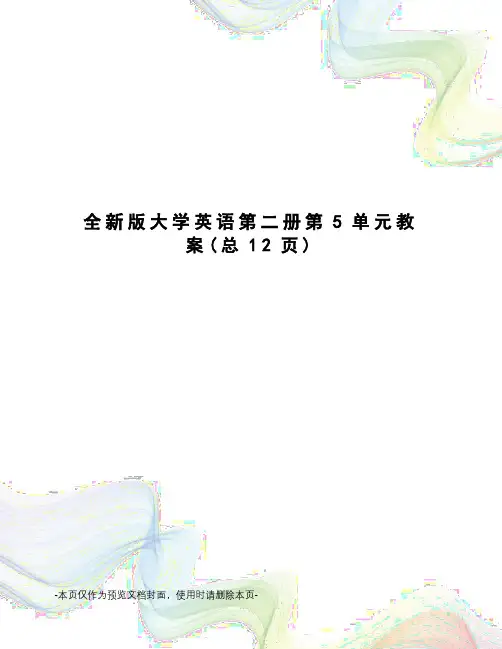
全新版大学英语第二册第5单元教案(总12页)-本页仅作为预览文档封面,使用时请删除本页-Teaching plan of Unit 5, Book 2Unit 5 Overcoming ObstaclesText A True HeightTeaching Objectives:Students will be able to:1.understand the maid idea ( dreaming and hard work helped Michael Stone on his way tosuccess ) and structure of the text ( narration with flashback);2.appreciate certain narrative skills (using details to bring out character; a surprise ending; use ofpuns);3.grasp the key language points in Text A and learn how to use them in context;4.understand the cultural background related to the content;5.express themselves more freely on the theme of overcoming obstacles after doing a series oftheme-related reading, listening, speaking, and writing activities;6.write a personal description with the focus on characteristic featuresTime Allotment: 5-6 periodsTeaching Method: Interactive, communicativeTeaching Procedures:I.Warming up1.Watch a part of video about a disabled person, Nick Vujicic2.More stories about overcoming obstaclesRead the stories about some figures in history to see how they overcame their obstacles, and guess who they are. ( See PPT Warm-up Exercises )3. Discuss the following questions in groupsA. what have you learned from these disabled people whom you’ve just learned from the video and the stories;B. what are the obstacles that you have been faced with in your life.C. the ways in which you overcame such difficulties4. After discussion, T may give Ss some suggestions on Overcoming Obstacles1)Get started.Often, once you begin, you'll find the task is easier than you expect.2)Break your task into smaller tasks.Take one big task and break it into smaller tasks. For instance, do part of your assignment each time rather than the entire one.3) Work with the time you have.Don't wait until you have time to do the entire thing. Instead, even if you only have fiveminutes, get started.4) Set small deadlines.After meeting each deadline, give yourself a reward. For example, play video games when you finish an hour of studying.5)Set anti-deadlines.If you don't finish your homework by 8:00, you can't watch your favorite TV program.6)Eliminate distractions.Turn off the TV. Don't answer the phone.7) Ask for help.Sometimes, the reason you don't start is because you don't know what to do. If that's the case, ask for help.8) Begin now.What one thing can you do right now that will move you closer to your goal.* Background InformationOlympicsOrganized and governed by the International Olympic Committee (IOC), the Olympic Games are the most important international sports event in the world held every four years.1. Olympic symbol: five interlocking red, blue, yellow, black, and green circles on a white field—represents the continents of the world joined in friendship2. Olympic motto: swifter, Higher, Stronger.3. Olympic Offices: Lausanne, Switzerland.4. Main events in Olympic history:--776 .~392 . Ancient Olympic Games were held in Olympia.--1896~now Modern Games began.--1912 Women are allowed to compete in the Games.--1924 Winter sports has been added to the Games.--2008 Beijing hosted the 29th Olympic Games.II. Global ReadingQuestions about the text1. What does the text title “True Height” mean?It has more than one meaning. It may refer to:1) the new bar heights that Michael cleared one after another;2) the tremendous obstacles Michael had overcome in attaining his goal.2. As the text consists of the main story and a flashback, can you figure out the flashback?The flashback is from Para. 3~5* Part Division of the Text* Scanning practice:Scan the whole text to find out all the words and phrases that are related to sports or stadium. And think about their Chinese equivalents. (For more details, see ppt.)III. Detailed ReadingFurther UnderstandingFor Part 1Description : Use your own words to draw a picture of the stadium on that day, including the weather, Michael’s appearance and inner feeling, the audience’s response, etc.For Part 2Questions and Answers1.From the description of Michael’ parents, what can you learn about his parents(Michael’s mother is romantic and passionate, while his father is a hard-core realist.) 2.What personality traits are attribute d to Michael’s success?(He is diligent, perseverant, optimistic, ambitious, etc.)For Part 3Compare Michael’s reaction before and after he cleared the bar at different height of the pole ( See PPT : Global Reading Chart Completion )For Part 4Discussion1.Why does the author keep the secret about Michael’s blindness until the last sentence?2.Who would you admire better, a Michael Stone with a sound body or a blind Michael Stone?*Key words:. sweat, fantasy, numerous, passion, coincide, alternate, vain, startle, in one’s mind’s eye* Writing SkillsAs the text consists of the main story and a flashback, the narration has to switch from the ongoing competition to earlier events and then return to the ongoing competition. How does the author manage to make these parts in the text flow smoothly?1.One way is to repeat a key word in the last sentence of a paragraph in the first sentence of thenext paragraph, .It also has the element of flying, and the thought of flying as high as a two-story building is a mere fantasy to anyone watching such an event.As long as Michael could remember he had always dreamed of flying.2.Another way is to pick up a key idea from a previous paragraph and repeat it in the sentenceintroducing the next paragraph, .All of M ichael’s vaults today seemed to be the reward for his hard work.IV. After Reading* DictationDictate the following proverbs to students and translate them into Chinese1. Where there’s a will, there’s a way. 有志者事竟成。
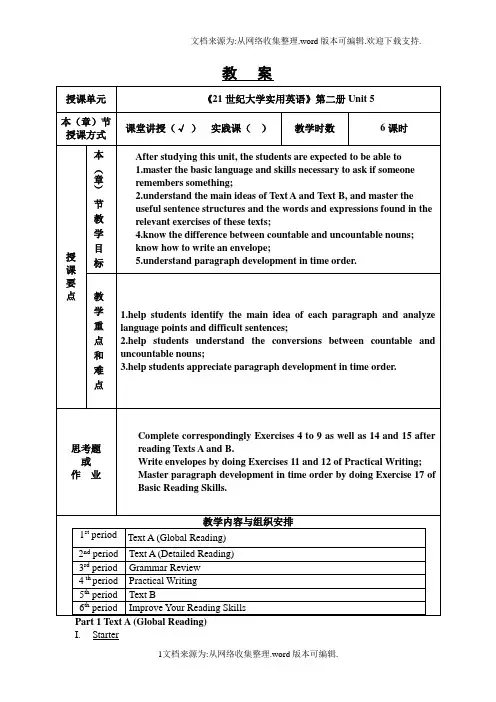
教案I.StarterHave you ever written or received a love note? Believe it or not, this oldest form of expressing love still works the best in the modern world. Suppose you are going to write a love note. What would you want to say to your lover? Discuss this with your classmates.After the discussion, Teacher asks several students to present their “love notes” to the class and read the two well-known love notes as follows:When You Are OldBY WILLIAM BUTLER YEATSWhen you are old and grey and full of sleep,And nodding by the fire, take down this book,And slowly read, and dream of the soft lookYour eyes had once, and of their shadows deep;How many loved your moments of glad grace,And loved your beauty with love false or true,But one man loved the pilgrim soul in you,And loved the sorrows of your changing face;And bending down beside the glowing bars,Murmur, a little sadly, how Love fledAnd paced upon the mountains overheadAnd hid his face amid a crowd of stars.朱生豪给妻子宋清如的情书中写道:“醒来觉得甚是爱你。
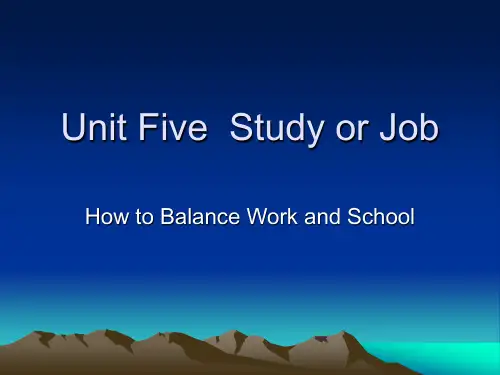
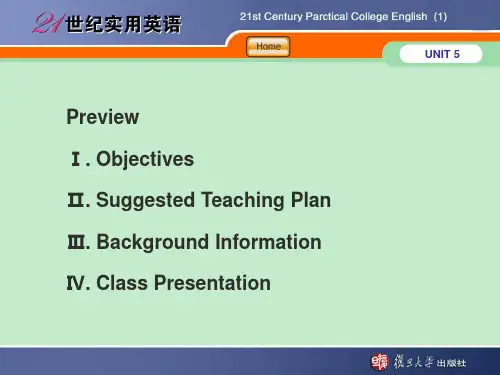
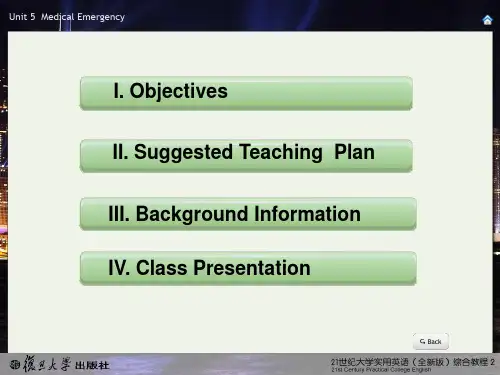
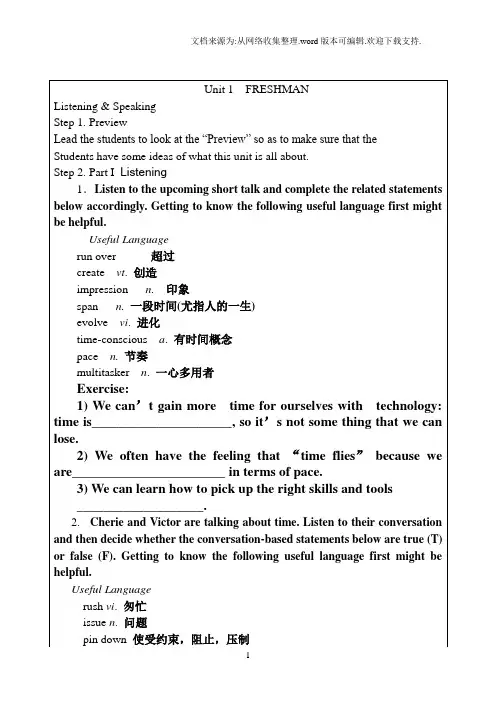
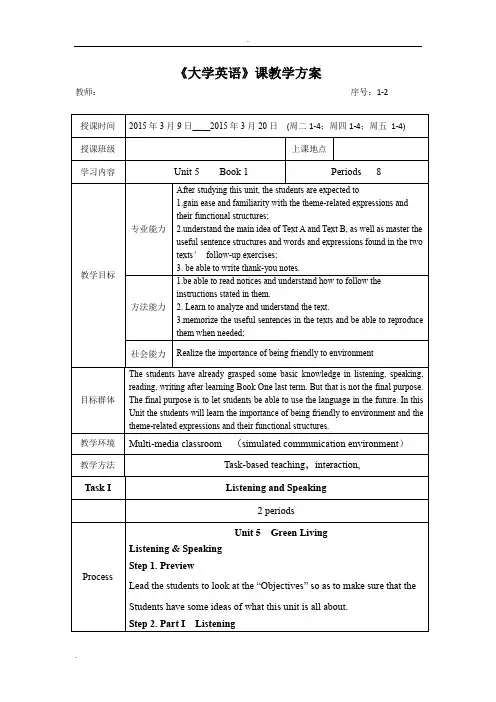
《大学英语》课教学方案教师:序号:1-2授课时间2015年3月9日____2015年3月20日(周二1-4;周四1-4;周五1-4)授课班级上课地点学习内容Unit 5 Book 1 Periods 8教学目标专业能力After studying this unit, the students are expected to1.gain ease and familiarity with the theme-related expressions andtheir functional structures;2.understand the main idea of Text A and Text B, as well as master theuseful sentence structures and words and expressions found in the twotexts’follow-up exercises;3. be able to write thank-you notes.方法能力1.be able to read notices and understand how to follow theinstructions stated in them.2. Learn to analyze and understand the text.3.memorize the useful sentences in the texts and be able to reproducethem when needed;社会能力Realize the importance of being friendly to environment目标群体The students have already grasped some basic knowledge in listening, speaking, reading, writing after learning Book One last term. But that is not the final purpose. The final purpose is to let students be able to use the language in the future. In this Unit the students will learn the importance of being friendly to environment and the theme-related expressions and their functional structures.教学环境Multi-media classroom (simulated communication environment)教学方法Task-based teaching,interaction,Task I Listening and Speaking2 periodsProcessUnit 5 Green LivingListening & SpeakingStep 1. PreviewLead the students to look at the “Objectives” so as to make sure that the Students have some ideas of what this unit is all about.Step 2. Part I Listening1.Listen to the upcoming short talk and then fill in the blanks in the sentences that follow with two or three words. First getting to know the useful language below might be helpful.Useful Languageextreme weather 极端天气activity n. 活动planet n. 星球up to 在于…, 取决于…go green 要有环保意识,保护环境for the sake of 为了breathe vt. 呼吸provide for 为…提供call for 要求carbon footprint 碳足迹(二氧化碳排放量)reduce vt. 减少urbanization n. 城市化turn a blind eye to 对…熟视无睹Script:Hi, everybody,Both the Beijing Olympics and the Shanghai Expo called for “green life.” How about your carbon footprint today? What have you done to reduce it?China is a big country with a large population. As in many other countries, urbanization is growing rapidly in China, which means more and more people are moving to the cities. As a result, the cities are getting bigger, and thus warmer.Today, nobody can turn a blind eye to such things as weather change, global warming, sea level rise, and extreme weathers. As you know, such things have much to do with our human activities. So we can’t go on like this. Nothing can be more important than to save our planet. This is the only planet on which we live.What should we do then? This is a question to all of us. It is up to each and every one of us to “go green.” Let’s live a low-carbon life, and reduce our carbon footprint —for the sake of our planet and forourselves.Nobody can give up breathing, drinking and eating. But we’ll have nothing if our planet cannot provide for us.2. In the upcoming conversation, Christine and Charles are talking about a new light source. Listen to them and then decide whether the conversation-based statements below are true or false. First getting to know the following useful language might be helpful.Useful LanguageLED 发光二极管Emit vt. 散发diode n. 二极管semiconductor n. 半导体increasingly ad. 光源light source 越来越多的remind vt. 使想起Unforgettable a. 难忘的electricity n. 电switch n. 转变I can’t imagine. 很难想象environment-friendly a. 环保的defnitely ad. 一定Script:Christine: Did you say LED? What do you mean by that?Charles: It’s the short form for light-emitting diode.Christine: I don’t get it. What’s that?Charles:Well, a LED is a semiconductor light source. Everywhere, LEDs are increasingly used for lighting. Expo 2010 Shanghai China is a good example.Christine: Oh, I see. You just reminded me of my trip to the Expo site. The lights were beautiful that evening. They were colorful and intensely bright. It was a really unforgettable trip.Charles:I bet it was. By the way, do you know how much electricity LEDs can save?Christine: I can’t imagine. But from what you said, I can tell the future oflights relies on LEDs.Charles:Yeah, the switch is a lready happening. In time, I’m sure their use will be even wider.Christine:You’ve got to be right. They are really environment-friendly. That’s so important!Charles:Yes, they are. We can definitely live a more low-carbon life with them.Christine: It sure is a good step in the right direction.Step 3. In the upcoming conversation, Charles and Christine are talking about the London Case Pavilion. Listen to them, and then answer the questions by choosing the best answer.Script:Charles:Speaking of energy efficiency, what was your favorite Shanghai Expo pavilion?Christine:I would say the London Case Pavilion. It’s a zero-carbon pavilion.Charles:I totally agree! When I visited it, I had lunch in the zero-carbon restaurant.Christine:Did you?Charles:Yes, I did. You know, even the chopsticks and dishes could be eaten right along with the food, because they were made of chocolate and pastry.Christine:You’re telling me! No wonder it’s really zero-carbon! Charles:Just about every square inch at the Expo site sent the same message: live a low-carbon life in every possible way.Christine:That’s so true. To have a better city is to have a better life. Charles:You took the words right out of my mouth. We cannot talk about a city without talking about its way of life.Christine:I know what you mean. And leading a low-carbon life is key to bettering our city.Charles:Hey, look! So many lights are on, right over our heads in this classroom!Christine:Let’s kill them. The light from all these windows is plenty. Charles:You kill these. I’ll take care of the rest.Christine:Ok.Homework Preview Text ATask II Text A How Green Is My City2 periodsProcess StepI Starter of the TextStepII Explanation of Text APara. 1 of Text A1. Questions about This Paragraph1) What is the main idea of the first part of the text?New ideas have enabled people to live clean and green in the city. 2. Language Points1) think about: remember or consider想到;考虑e.g. I thought of you when they wanted someone who could speak English.当他们需要一个会讲英语的人时,我想到了你。
21世纪大学实用英语综合教程全新版第2册教学设计一、教学目标•通过本教材的学习,使学生能熟练运用英语进行日常交流和沟通•通过课程安排,提高学生的听、说、读、写等语言综合技能•培养学生的语言应用能力和交际能力,让学生具有较强的能力应对生活和工作中的实际情境二、教学内容本教材共分为五个单元,每个单元包含听、说、读、写四个方面的教学内容。
教材主要内容如下:第一单元:Society1.Talking Points2.Listening Comprehension3.Reading Comprehension4.Writing第二单元:Relationships1.Talking Points2.Listening Comprehension3.Reading Comprehension4.Writing第三单元:Education1.Talking Points2.Listening Comprehension3.Reading Comprehension4.Writing第四单元:Technology1.Talking Points2.Listening Comprehension3.Reading Comprehension4.Writing第五单元:Globalization1.Talking Points2.Listening Comprehension3.Reading Comprehension4.Writing三、教学方法1.任务型教学法。
学生需要完成一定的任务,从而真正理解并掌握所学内容。
2.情境教学法。
根据实际情境模拟日常场景,让学生在真实环境中学习和交流。
3.合作学习法。
让学生在小组内协作完成任务,培养他们的团队合作精神和交流能力。
4.多媒体教学法。
借助多媒体技术,提高学生的学习兴趣和参与度。
四、教学重难点重点•学生的听、说、读、写的综合技能的培养•学生的语言应用能力和交际能力的提高•学生对国际化背景下的社会问题和主题进行思考难点•学生在一个新环境下使用英语进行交流时的自信心和技巧•学生对一些文化和思维方式的理解和适应五、教学评价1.日常评价。
Ⅰ. Objectives1.master the basic language and skills necessary to ask if someone remembers something;2.understand the main ideas of Text A, Text B and Text C, and master the useful sentence structures and the words and expressions found in the relevant exercises of the first two texts;3.know the difference between countable and uncountable nouns;4.know how to write an envelope;5.understand paragraph development (2).II. Background InformationLegacyLegacy, in the law of wills, gift or bequest of real or personal property by will. A legacy becomes effective after the death of its author, who is known as the testator. The three principal types of legacy are a specific legacy, which consists of a definite article of personal property or parcel of real property; a general legacy, which consists of a certain amount of money payable from the estate as a whole; and a demonstrative legacy, which consists of a certain amount of money to be paid the legatee, or recipient, from a specific fund or other definite source named by the testator.Examples of these types of legacies are the following: (specific legacy) “I bequeath to my son A. B. my watch and all my jewelry”; (general legacy) “I bequeath to my son A. B. the sum of $1,000”; (demonstrative legacy) “I bequeath to my son A. B. the sum of $1,000 payable to him out of the proceeds of the securities of company X that I may own at the time of my death.”Sotheby’sSotheby’s is a famous auction house with its main offices in New York and London, where valuable paintings, rare books etc. are sold.III Words1. precious adj.贵重的,宝贵的【经典例句】precious gems /rubies/emeralds 宝石,红宝石,绿宝石。
《21世纪大学实用英语》(综合教程)课程教学大纲课程代码:学时:学分:第一部分:课程教育目标一、课程的性质和任务课程的性质:本教材是普通高等教育“十一五”国家级规划教材。
课程的任务:本课程教学的任务是:培养学生掌握一定的英语基础知识和技能,具有一定的听、说、读、写、译的能力,从而能借助词典阅读和翻译有关英语业务资料,在涉外交际的日常活动和业务活动中进行简单的口头和书面交流,并为今后进一步提高英语的交际能力打下二、课程相关的衔接本课程需掌握一定的英语基础知识,认知1000个英语单词,掌握基本的英语语法规则,能听懂日常和涉外业务活动中使用的英语对话,能运用已知的词汇和语法,句子结构等写出较简单命题作文。
三、教学的基本要求本课程要求在加强英语语言基知识和基本技能训练的同时,要重视培养学生实际使用英语进行交际的能力。
通过本课程的学习,学生应该达到下列要求: 1.基础知识要求1)词汇认知3200个英语单词(包括入学时要求掌握的1000--1600个词)以及由这些词构成的常用词组,掌握其中大约2000个单词的正确拼写、英汉互译及基本用法。
学生还应结合专业英语学习,认知400个专业英语词汇。
2)语法进一步巩固和掌握基本的英语语法规则,并在听、说、读、写、译中能正确运用其所学语法知识。
3)听力能听懂日常和涉外业务活动中使用的结构简单、发音清楚、语速较慢(每分钟100词左右)的英语对话和不太复杂的陈述,理解基本正确。
4) 口语能用英语进行一般的课堂交际,并能在日常的涉外业务活动中进行简单的交流。
5) 阅读能阅读中等难度的一般题材的简短英文资料,理解正确。
在阅读生词不超过总词数3%的英文资料时,阅读速度不低于每分钟70词。
能读懂通用的简短实用文字材料,如信函、技术说明书、合同等,理解正确。
6) 写作:能就一般性题材,在30分钟内写出80—100词的命题作文;能填写和模拟套写简短的英语应用文,如填写表格与单证,套写简历、通知、信函等,词句基本正确,无重大语法错误,格式恰当,表达清楚。
Unit 1Text A: Winston Churchill—His Other LifeText B: Little Sister of the PoorText C: Diana, Princess of Wales: 1961-1977教学目标及基本要求:Objectives:Students will be able to:1)grasp the main idea and structure of the Text A and Text B;2)Appreciate the organization skills demonstrated in Text A;3)master the key language points and grammatical structures in TextA and Text B;4)conduct a series of reading, listening, speaking and writingactivities related to the theme of the unit.2. 教学内容及学时分配:Time allotment:1st period: pre-reading; text organization2nd period: while-reading3rd period: while-reading4th period: while-reading and post-reading activities practice5th period: Exercises after Text A6th period: Reading practice of Text B7th period & 8th period: listening3. 教学重点及难点:Important language points in the text:1. love affair—romance between two people who love each other but who are not married to each other; great enthusiasm or liking (for sth.). The girl’s love affair with the 60-year-old man worries her parents..She started her love affair with ballet when she was only six.2. circumstances n. (pl.)—conditions of a situation which has an effect on what is done oron the way sth. is done. In some circumstances it may be necessary for the manager to come here in person.Even under the most favorable circumstances this is not easy.3. mission n.—an important job sb. is sent to do in another place, esp. for a military or political purpose. The foreign minister’s mission to Par is is to negotiate a cease-fire.It is his sole mission to expand the company’s business abroad.4.price n.—what must be given, done, or undergone to obtain or compensate for sth.. We paid a heavy price for the victory, for we lost 10,000 soldiers. Translate : This is a small price to pay for independence.Key: 这是为独立付出的小小代价。